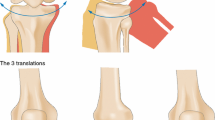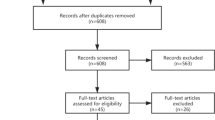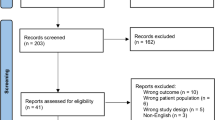Abstract
Purpose
To explore whether the severity of contralateral knee osteoarthritis (OA) is associated with OA progression in ipsilateral knee with early OA.
Methods
Knees in early OA (Kellgren-Lawrence grade (KLG):1–2) with intact baseline demographic and clinical data were retrieved from OAI database and defined as target knees. The target knees were divided into the exposure group (contralateral knees KLG 3 to 4) and the control group (contralateral knees KLG 0 to 2). Both groups underwent propensity score matching (PSM) concerning demographic data, as well as radiographic and clinical outcomes at the baseline. The primary outcome was the upgrade of KLG in the target knee in the first 12 and 24 months. The secondary outcome was the incidence of knee arthroplasty in ipsilateral knee during the first 108 months.
Results
One thousand seven hundred fifty-two knees were included, with 449 in the exposure cohort and 1276 in the control cohort. Four hundred thirty-four knees in each group were matched after PSM. Target knees in the exposure cohort showed a significantly higher rate of radiographic progression in the first 12 months (12.9% vs. 5.1%, P < 0.001) and 24 months (19.6% vs. 8.1%, P < 0.001). As for the risk of future arthroplasty, a significant difference was also found between the two groups (7.8% vs. 4.0%, P = 0.02). Kaplan–Meier analysis showed that the 108-month accumulated knee survival rate was significantly lower in the exposure group (P = 0.01).
Conclusion
The ipsilateral knee with early-stage OA is prone to have worse early to mid-, and long-term prognosis in the circumstance of contralateral radiographic advanced knee OA.
Key Points •Identifying early knee osteoarthritis (OA) with a high risk of radiographic progression and future arthroplasty enables early personalized intervention. •This is a novel study to investigate the relationship between the risk of future arthroplasty and contralateral knee status. •Propensity score matching holds promise to minimize selection bias in observational studies. •Knees with early OA are prone to have a high risk of radiographic progression and future arthroplasty in the circumstance of contralateral advanced knee OA. |



Similar content being viewed by others
References
Deshpande BR, Katz JN, Solomon DH, Yelin EH, Hunter DJ, Messier SP et al (2016) Number of persons with symptomatic knee osteoarthritis in the US: impact of race and ethnicity, age, sex, and obesity. Arthritis Care Res (Hoboken) 68(12):1743–1750
Driban JB, Harkey MS, Barbe MF, Ward RJ, MacKay JW, Davis JE et al (2020) Risk factors and the natural history of accelerated knee osteoarthritis: a narrative review. BMC Musculoskelet Disord 21(1):332
Hunter DJ, Bierma-Zeinstra S (2019) Osteoarthritis Lancet 393(10182):1745–1759
Lansdown DA. 2019 Does MRI of knee cartilage help to characterize osteoarthritis severity?: commentary on an article by Joshua S. Everhart, MD, MPH, et al.: "full-thickness cartilage defects are important independent predictive factors for progression to total knee arthroplasty in older adults with minimal to moderate osteoarthritis. Data from the Osteoarthritis Initiative". J Bone Joint Surg Am. 101(1):e4.
Bannuru RR, Osani MC, Vaysbrot EE, Arden NK, Bennell K, Bierma-Zeinstra SMA et al (2019) OARSI guidelines for the non-surgical management of knee, hip, and polyarticular osteoarthritis. Osteoarthritis Cartilage 27(11):1578–1589
Conaghan PG, Kloppenburg M, Schett G, Bijlsma JW (2014) Osteoarthritis research priorities: a report from a EULAR ad hoc expert committee. Ann Rheum Dis 73(8):1442–1445
Cotofana S, Benichou O, Hitzl W, Wirth W, Eckstein F (2014) Is loss in femorotibial cartilage thickness related to severity of contra-lateral radiographic knee osteoarthritis?–longitudinal data from the Osteoarthritis Initiative. Osteoarthritis Cartilage 22(12):2059–2066
Günther KP, Stürmer T, Sauerland S, Zeissig I, Sun Y, Kessler S et al (1998) Prevalence of generalised osteoarthritis in patients with advanced hip and knee osteoarthritis: the Ulm Osteoarthritis Study. Ann Rheum Dis 57(12):717–723
Metcalfe AJ, Andersson ML, Goodfellow R, Thorstensson CA (2012) Is knee osteoarthritis a symmetrical disease? Analysis of a 12 year prospective cohort study. BMC Musculoskelet Disord 13:153
Eckstein F, Maschek S, Roemer FW, Duda GN, Sharma L, Wirth W (2019) Cartilage loss in radiographically normal knees depends on radiographic status of the contralateral knee - data from the Osteoarthritis Initiative. Osteoarthritis Cartilage 27(2):273–277
Riddle DL, Stratford PW, Perera RA (2016) The incident tibiofemoral osteoarthritis with rapid progression phenotype: development and validation of a prognostic prediction rule. Osteoarthritis Cartilage 24(12):2100–2107
Wu R, Ma Y, Yang Y, Li M, Zheng Q, Fu G (2022) A clinical model for predicting knee replacement in early-stage knee osteoarthritis: data from osteoarthritis initiative. Clin Rheumatol 41(4):1199–1210
Emmanuel K, Quinn E, Niu J, Guermazi A, Roemer F, Wirth W et al (2016) Quantitative measures of meniscus extrusion predict incident radiographic knee osteoarthritis–data from the Osteoarthritis Initiative. Osteoarthritis Cartilage 24(2):262–269
Roth M, Emmanuel K, Wirth W, Kwoh CK, Hunter DJ, Hannon MJ, et al. 2020 Changes in medial meniscal 3D position and morphology predict knee replacement in rapidly progressing knee osteoarthritis - data from the osteoarthritis initiative (OAI). Arthritis Care Res (Hoboken).
Felson DT, Niu J, Guermazi A, Sack B, Aliabadi P (2011) Defining radiographic incidence and progression of knee osteoarthritis: suggested modifications of the Kellgren and Lawrence scale. Ann Rheum Dis 70(11):1884–1886
Hangaard S, Boesen M, Bliddal H, Wirth W (2022) Do Ahlback scores identify subgroups with different magnitudes of cartilage thickness loss in patients with moderate to severe radiographic osteoarthritis? One-year follow-up data from the Osteoarthritis Initiative. Skeletal Radiol 51(4):777–782
Madry H, Kon E, Condello V, Peretti GM, Steinwachs M, Seil R et al (2016) Early osteoarthritis of the knee. Knee Surg Sports Traumatol Arthrosc 24(6):1753–1762
Chapple CM, Nicholson H, Baxter GD, Abbott JH (2011) Patient characteristics that predict progression of knee osteoarthritis: a systematic review of prognostic studies. Arthritis Care Res (Hoboken) 63(8):1115–1125
Roemer FW, Kwoh CK, Fujii T, Hannon MJ, Boudreau RM, Hunter DJ et al (2018) From Early radiographic knee osteoarthritis to joint arthroplasty: determinants of structural progression and symptoms. Arthritis Care Res (Hoboken) 70(12):1778–1786
Malhas L, Perlas A, Tierney S, Chan VWS, Beattie S (2019) The effect of anesthetic technique on mortality and major morbidity after hip fracture surgery: a retrospective, propensity-score matched-pairs cohort study. Reg Anesth Pain Med 44(9):847–853
Fu G, Li H, Wang H, Zhang R, Li M, Liao J et al (2021) Comparison of peripheral nerve block and spinal anesthesia in terms of postoperative mortality and walking ability in elderly hip fracture patients - a retrospective, propensity-score matched study. Clin Interv Aging 16:833–841
Austin PC (2011) An introduction to propensity score methods for reducing the effects of confounding in observational studies. Multivariate Behav Res 46(3):399–424
Sica GT (2006) Bias in research studies. Radiology 238(3):780–789
Benedetto U, Head SJ, Angelini GD, Blackstone EH (2018) Statistical primer: propensity score matching and its alternatives. Eur J Cardiothorac Surg 53(6):1112–1117
Yang JY, Webster-Clark M, Lund JL, Sandler RS, Dellon ES, Sturmer T (2019) Propensity score methods to control for confounding in observational cohort studies: a statistical primer and application to endoscopy research. Gastrointest Endosc 90(3):360–369
Naili JE, Broström EW, Clausen B, Holsgaard-Larsen A (2019) Measures of knee and gait function and radiographic severity of knee osteoarthritis - A cross-sectional study. Gait Posture 74:20–26
Iijima H, Inoue M, Suzuki Y, Shimoura K, Aoyama T, Madoba K et al (2020) Contralateral limb effect on gait asymmetry and ipsilateral pain in a patient with knee osteoarthritis: a proof-of-concept case report. JBJS Case Connect 10(1):e0418
Gustafson JA, Anderton W, Sowa GA, Piva SR, Farrokhi S (2019) Dynamic knee joint stiffness and contralateral knee joint loading during prolonged walking in patients with unilateral knee osteoarthritis. Gait Posture 68:44–49
Zhu J, Zhu Y, Xiao W, Hu Y, Li Y (2020) Instability and excessive mechanical loading mediate subchondral bone changes to induce osteoarthritis. Ann Transl Med 8(6):350
Jones RK, Chapman GJ, Findlow AH, Forsythe L, Parkes MJ, Sultan J et al (2013) A new approach to prevention of knee osteoarthritis: reducing medial load in the contralateral knee. J Rheumatol 40(3):309–315
Khoja SS, Almeida GJ, Freburger JK (2020) Recommendation rates for physical therapy, lifestyle counseling, and pain medications for managing knee osteoarthritis in ambulatory care settings: a cross-sectional analysis of the national ambulatory care survey (2007–2015). Arthritis Care Res (Hoboken) 72(2):184–192
Smith HK, Wylde V, Lingard EA, Blom A, Metcalfe C, Ben-Shlomo Y (2013) The effect of pain after total knee arthroplasty on the contralateral, nonreplaced knee. J Bone Joint Surg Am 95(4):315–322
Acknowledgements
The OAI is a public-private partnership comprised of five contracts (N01-AR-2-2258; N01-AR-2-2259; N01-AR-2-2260; N01-AR-2-2261; N01-AR-2-2262) funded by the National Institutes of Health, a branch of the Department of Health and Human Services, and conducted by the OAI Study Investigators. Private funding partners include Merck Research Laboratories; Novartis Pharmaceuticals Corporation, GlaxoSmithKline; and Pfizer, Inc. Private sector funding for the OAI is managed by the Foundation for the National Institutes of Health. This manuscript was prepared using an OAI public use data set and does not necessarily reflect the opinions or views of the OAI investigators, the NIH or the private funding partners.
Funding
This work was supported by the Guangdong Basic and Applied Basic Research Foundation (2022A1515011103), (2020A1515110511) and (2021A1515110458), NSFC Incubation Program of GDPH (KY012021163), and Science and Technology Program of Guangzhou (202102020050) and (202102020427) and the Program of Administration of Traditional Chinese Medicine of Guangdong Province (20212033).
Author information
Authors and Affiliations
Corresponding author
Ethics declarations
Disclosures
None.
Additional information
Publisher's note
Springer Nature remains neutral with regard to jurisdictional claims in published maps and institutional affiliations.
Rights and permissions
About this article
Cite this article
Wu, R., Fu, G., Li, M. et al. Contralateral advanced radiographic knee osteoarthritis predicts radiographic progression and future arthroplasty in ipsilateral knee with early-stage osteoarthritis. Clin Rheumatol 41, 3151–3157 (2022). https://doi.org/10.1007/s10067-022-06235-7
Received:
Revised:
Accepted:
Published:
Issue Date:
DOI: https://doi.org/10.1007/s10067-022-06235-7




